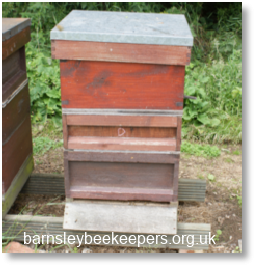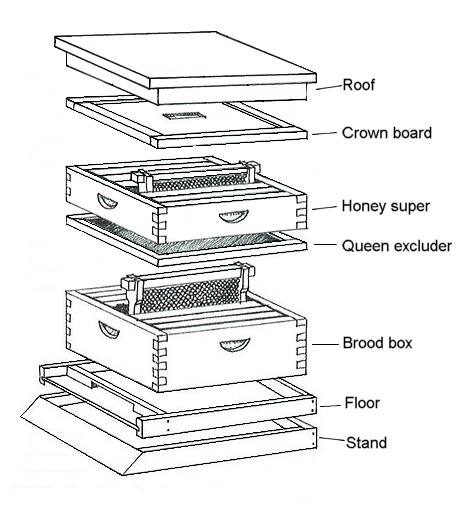
Historically, people collected honey from the wild. Wild hives in hollows in trees or hanging beneath over-
It wasn’t until 1853, when in America the Reverend L. L. Langstroth published his ideas for a new design of hive, that beekeeping entered the “modern era” . Rev Langstroth studied bees closely and had noticed that bees build their wild comb with a specific distance between them (the bee space). He designed a hive with moveable frames set apart so that the bee space could be maintained. Furthermore, he separated the colony into a brood box in which the queen laid her eggs and a honey super into which the colony stored its excess honey.
His design revolutionised the world of beekeeping by giving beekeepers the ability to manipulate colonies by moving individual frames and by providing a separate place from which honey could be taken (with out damaging the brood area). A further advantage of the “Langsroth hive” is that it can be extended or reduced according to colony size and availability of nectar.
Hive Structure
The Langstroth hive is one of he most commonly used hives in the world. Most other types of hive are based on this model of hive.
In America, the Langstroth hive still has a large following albeit commercial beekeepers prefer the Dadant (or modified Dadant) hive due to its larger brood area. In the UK the most commonly used and recommended hive amongst amateur beekeepers is the British National Hive with commercial beekeepers preferring the Commercial (or modified Commercial) hive -
The basic structure of all these hives is essentially the same as the Langstroth but the dimensions and finer structure differ from one another. The diagram opposite shows the main parts of a typical (Langstroth-
The main parts of the hive are the brood box (or brood chamber) along with the frames, floor, crown board and roof.
The roof
The hive roof is structured to keep the rain off the hive (bees survive cold weather very well, but becoming damp, particularly in winter, often finishes them off).
Brood Box
The brood box holds the brood frames where the colony, in effect, lives. The queen lays her eggs here and
the new brood are reared. Stores of pollen and honey will be placed toward the outer edge of the comb. Brood boxes fall into one of two camps. These are either top bee space or bottom bee space boxes. As suggested by their names, top bee space brood boxes provide a “beeway” for the bees to move about across the tops of the frames whilst bottom bee space only provide a beeway at the bottom of the frames. Different beekeepers prefer different hives (top or bottom bee space), but whichever is used, care must be taken not to place the opposing super on a brood box (I.e. a bottom bee space brood box with a top bee space super) as this will close the available beeway down to virtually nothing.

Frames
The frames -
Crown Board
The crown board is important for containing the colony in the brood box and preventing the colony from building wild comb in the roof void.
Floor
The floor completes the main section of the hive. This can either be solid or contain a mesh base (important for managing Varroa mite. Typically the wide entrance of the floor will accommodate an entrance block that restricts the entrance to something more easily defended by the bees.
